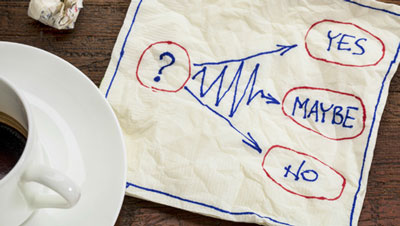To Lease or Not to Lease
MONEY SAVER

Buy/lease decisions are much more than a matter of taxes.
Buy or lease? That is the question that arises whenever a
business needs a new asset. The question usually elicits
a follow-up comment that a 100% write-off of the lease
expense is available, whereas a purchased asset can only
write off the capital cost allowance. The conclusion of
the discussion is that there is a tax advantage to leasing.
Advantages of Leasing
- Your business gets the full use of the asset while
the cost is spread over a number of years (i.e., there
is no immediate drain on cash flow). This may
be important if the business has limited lines of
credit, limited cash reserves or is cyclical and the
asset is required immediately. - The lower cash outlay may allow the business to
acquire better equipment with only a marginal
increase in cash outlay, whereas a significant additional
capital outlay would be required to purchase
the asset. - Businesses normally establish cash flow and budgets
based on operating revenue and expenses and
often ignore the need to budget for capital asset
acquisitions. Because the lease expense is a regular
monthly withdrawal, budgeting for future expenditures
may be easier than predicting the impact
on cash flow and profit and loss of a major capital
purchase. - Depending on the product and the leasing company,
you may find it easier to cancel the existing
lease and renegotiate a lease on a newer, better
piece of equipment with payments that are not
much different from those of the existing lease. If
technology in your business is changing rapidly,
leasing may be advantageous. - Leasing from the same company that manufactures
the asset may be beneficial if the asset turns
out to be a lemon. Because the manufacturer wants
to retain the customer, it may be more willing to
provide a replacement.
The lessor continues to control the
asset through the leasing contract.
Disadvantages of Leasing
The lessor continues to control the asset through
the leasing contract.
This may have the following
disadvantages:
- Payments may continue longer than the usefulness
of the asset. - If the lessor is financing the asset, it may not be
possible to upgrade the equipment until the lease
is paid in full or a buyout has been negotiated. - Businesses in possession of the asset after the lease
period must continue payments even though the
lease has been fully paid. - Lessees are responsible for maintaining the equipment
unless maintenance is covered or a separate
charge is paid. In fact, you may be required to
follow a predetermined maintenance schedule. If
the equipment is not maintained, the lessor may
charge your company for restoring the asset to its
original condition. - An operating lease (i.e., the term of the lease is
shorter than the useful life of the asset) is an “off
balance sheet” form of financing because only
the rental expense is recorded on the income
statement. Nevertheless, the lease creates a legal
obligation even though nothing shows up on the
balance sheet. Management may be unaware of
this legal obligation for this kind of indebtedness.
This situation can be mitigated by treating the
lease as a capital lease and recording the value of
the leased asset on the balance sheet and showing
a corresponding liability. In some instances the
contractual obligation is shown within the notes
to the financial statements.
Tax Considerations
Normally, when an asset is leased, the cost of the lease
is immediately expensed and the income is reduced
by the lease amount. If, for instance, the lease cost is
$1,000 per annum and the corporate tax rate is 17%,
the income tax expense will be reduced by $170. The
GST/HST input tax credit (ITC) is calculated each
month based on the monthly lease amount.
When an asset is purchased, the cost of the asset is
capitalized and, for purposes of the Canada Revenue
Agency, the capital cost allowance (CCA) is applied to
the cost of the asset and the amount is deducted for
income tax purposes. The CCA amount is calculated
using a percentage (such as 20%) of the cost of the
asset. In the first year of purchase the CCA is usually
limited to one-half of the CCA calculated on the
purchase price. Thus, if an asset cost $1,000, the first
year CCA would calculate as 20% of $1,000 equals
$200 divided by 2 or $100. In the ensuing years, full
CCA is calculated on the original asset cost less the
accumulated capital cost allowance. ($1,000 less $100
or $900 times 20% or $180) until the asset is effectively
amortized.
From a tax viewpoint, the first-year deduction for the
CCA equivalent is $100. A first-year tax benefit approximates
$17 assuming (17% of $100); whereas in the
second year, the tax benefit approximates $31 (17% of
20% of $900). If the asset is purchased, the ITC on the
original cost is calculated on the initial purchase cost
and applied against the GST/HST payable. Further, if
the capital asset is financed, the interest on the loan is
a deduction from income.
More Than Just Taxes
Making a decision as to whether to lease or buy an
asset should take into consideration more than just the
tax implications. Cash flow, maintenance, financing
ability, obsolescence, long-term capital asset needs
combined with the impact on the financial statement
should all be factors when discussing the pros and cons
with your CPA.
Disclaimer
The information provided on this page is intended to provide general information. The information does not take into account your personal situation and is not intended to be used without consultation from accounting and financial professionals. Allan Madan and Madan Chartered Accountant will not be held liable for any problems that arise from the usage of the information provided on this page.


SOCIAL CONNECT